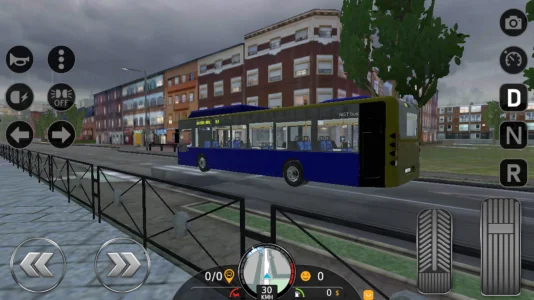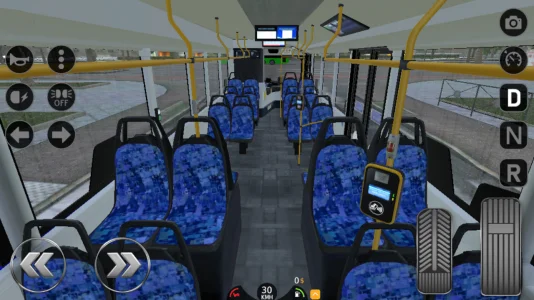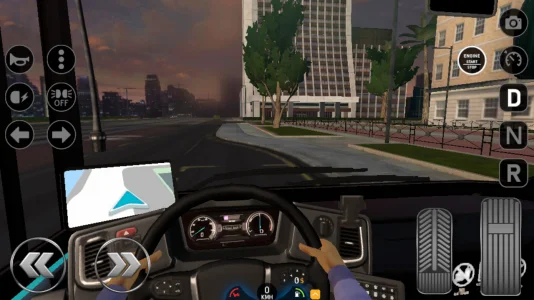Download Bus Simulator: EVO MOD For Free
*Bus Simulator: EVO* is a vehicle simulation game developed by Romanian studio Ovilex Software. The game offers an immersive experience where players assume the role of a professional bus driver, focusing on realistic driving physics and fleet management. Players operate a diverse roster of buses across various maps, manage passenger dynamics, and build their own transport company. The core gameplay combines a sophisticated physics engine with strategic business simulation elements, offered through career, free-ride, and online multiplayer modes.
Screenshot Gallery



Bus Simulator: EVO Overview
Game Identity and Developer Profile
Unpacking the Name: Bus Simulator : EVO, 2023, and Beyond
Bus Simulator : EVO establishes itself as a prominent title within the vehicle simulation genre, offering a comprehensive experience for the mobile gaming market. The game presents an immediate complexity regarding its identity, as it is known by several names across different platforms. The primary title on the Google Play Store and official developer channels is Bus Simulator : EVO. However, its technical package ID, com.Ovilex.BusSimulator2023, leads to the common use of the name Bus Simulator 2023, particularly within APK distribution communities. A further variation exists on console platforms like the PlayStation, where the game is marketed as Bus Driving Simulator : EVO. This branding fragmentation necessitates a clear understanding that these different titles all refer to the same core software product, adapted for various digital storefronts and hardware ecosystems.The Developer: Ovidiu Pop and Ovilex Software
The entity responsible for Bus Simulator : EVO also requires clarification. The Google Play Store lists the developer under the individual name "Ovidiu Pop," which cultivates the image of an independent creator. In reality, this name is associated with a larger corporate structure. The development studio is officially known as Ovilex Software, the public-facing brand, and operates under the legal name SC Ovilex Soft SRL. This Romanian studio, founded in 2011, possesses a deep portfolio of successful vehicle simulation titles, including Truck Simulator USA : Classic and Driving School Simulator : EVO. This background confirms that the game is the product of an experienced commercial studio with significant expertise in the simulation genre, rather than a solo project. The branding strategy likely leverages the indie developer appeal while being backed by established company resources.Core Simulation and Gameplay Mechanics
The 1:1 Physics Engine and Driving Realism
The central gameplay pillar of Bus Simulator : EVO is its proprietary "1:1 physics engine," which the developer promotes as a new standard for realism on mobile platforms. This engine meticulously simulates the dynamic properties of heavy vehicles. Players experience the tangible weight of each bus, the nuanced response of the suspension system to road imperfections, and the distinct handling characteristics of different models, from standard city buses to large articulated variants. The pursuit of authenticity extends to the audio design, which incorporates realistic engine and environmental sounds to heighten immersion. On supported hardware like the PlayStation 5, this realism is further enhanced through haptic feedback from the DualSense controller, translating road textures and vehicle feedback into physical sensations. While the game targets a high degree of simulation, it also provides accessibility options, such as simplified gear shifting, to cater to a broader audience of players.Dynamic World Interaction Systems
To create a believable and challenging environment, Bus Simulator : EVO integrates several dynamic systems that govern the game world. These systems add layers of consequence and responsibility to the core driving experience.- Intelligent Traffic System: An AI-powered system populates the world with other vehicles, pedestrians, and animals, creating realistic traffic scenarios that require players to obey traffic laws and react to emergent events. However, reports indicate this feature is notably absent in the online multiplayer mode, which significantly impacts its gameplay.
- Passenger Dynamics: A core gameplay loop involves the management of animated passengers who board and alight at designated stops. Player performance, including smooth driving and adherence to schedules, directly influences passenger satisfaction, which serves as a key performance metric.
- Dynamic Environments: The game features a complete day/night cycle and variable weather conditions such as rain and snow. These elements are not merely cosmetic; they directly affect gameplay by altering visibility and road friction, forcing drivers to adapt their technique to the conditions.
Controls and User Interface
Bus Simulator : EVO offers a versatile control suite to accommodate various player preferences on the Android and iOS platforms. Users can select from a virtual steering wheel for precise analog input, on-screen buttons for a more direct digital control scheme, or tilt controls that utilize the device's internal accelerometer. The user interface is designed for functionality, providing access to a main menu for comprehensive adjustments to graphics, audio, and gameplay settings. It also includes practical features, such as the ability to reset a stuck vehicle to the road, preventing sessions from being prematurely ended by minor mistakes.Fleet Management and Business Simulation
Beyond the driving experience, Bus Simulator : EVO incorporates a strategic layer through its "Bus company management system." This feature transforms the game from a pure driving simulator into a more complex business simulation. Players begin with a small operation and must earn in-game currency by successfully completing routes. This revenue can then be reinvested into the company to purchase additional buses for the fleet. Players can assign these newly acquired vehicles to specific routes and hire AI drivers to operate them, generating passive income. The system also includes tools for creating custom route schedules, granting players strategic control over their transportation network's expansion and efficiency.Analysis of Available Game Modes
Career Mode: The Path to a Transport Empire
Career Mode constitutes the primary progression-based experience in Bus Simulator : EVO. In this mode, players are tasked with building a transportation company from the ground up. The core gameplay loop involves completing routes, managing passenger satisfaction, and obeying traffic laws to earn in-game currency. This currency is essential for unlocking new content, including more advanced buses and access to new city routes. However, this progression system is intrinsically linked to the game's aggressive monetization model. Many routes are gated, requiring specific bus types that must be purchased with a large amount of in-game currency, pushing players towards either a significant time investment or real-money transactions.Free-Ride Mode: A Sandbox for Exploration
In direct contrast to the structured objectives of Career Mode, Free-Ride Mode offers a pure sandbox environment. This mode allows players to select any unlocked bus and drive freely across the game's expansive maps without the constraints of schedules, passengers, or penalties. Available from the start, Free-Ride serves as an ideal space for players to practice vehicle handling, explore the diverse environments at their own pace, or simply enjoy the core driving mechanics in a stress-free setting. Its accessibility and freedom make it a highly valued feature among the player community.Online Multiplayer: A Flawed Social Experience
The Online Multiplayer Mode is presented as a key feature, designed for cooperative and competitive play. The system facilitates social interaction through friend lists and live chat, allowing players to join cooperative routes on open-world maps. It also integrates leaderboards and achievements to foster competition. Despite its promotion, this mode is subject to severe criticism from the user base. The most significant functional flaw is the complete absence of AI traffic, which renders the game's cities sterile and removes the primary challenge of navigation. Furthermore, the mode suffers from a "pay-to-win" dynamic, where players who have purchased premium buses with real money possess a significant performance advantage, undermining any basis for fair competition.Content Breakdown: Vehicles, Maps, and Customization
The Extensive Vehicle Roster
Bus Simulator : EVO features a diverse fleet of over 50 different bus models. The roster includes a wide variety of vehicle types, such as standard city buses, long-distance coach buses, and specialized school buses. The collection also spans different propulsion technologies, featuring diesel, hybrid, and fully electric vehicles. A notable inclusion is the articulated or "bendy" bus, which presents a unique handling challenge due to its pivoting joint. While the sheer variety is a major asset, the accessibility of this fleet is a point of contention, as many of the more desirable models are locked behind the game's demanding economy.A Tour of the World Atlas
The game world is built on a large scale, offering numerous maps based on locations across North America, South America, Europe, and Asia. Advertised cities include San Francisco, Buenos Aires, Paris, London, and Shanghai, among others. The environments are varied, featuring urban centers, countryside, deserts, and snow-covered mountain passes. This global scope provides significant visual diversity and a range of driving challenges. However, the authenticity of these locations has been questioned, with some reviews of the console version noting that maps like Los Angeles and Munich feel generic and lack faithfulness to their real-world counterparts, suggesting a focus on content breadth over locational accuracy.Vehicle Tuning and Personalization
A deep and robust customization system allows players to personalize their vehicle fleet extensively. This feature is a significant draw, enabling a high degree of player expression. Exterior customization options include custom paint jobs, decals, flags, and body modifications. The detailed vehicle interiors can also be tailored to the player's liking. Beyond cosmetics, the game allows for the tuning of performance parts, which can alter a bus's handling, acceleration, and braking characteristics. This level of personalization adds considerable replay value and fosters a stronger connection between the player and their vehicles.Deconstructing the Monetization and In-Game Economy
The Freemium Model and In-App Purchases
Bus Simulator : EVO operates on a freemium, or free-to-play, business model. The game is free to download and install, with revenue generated through in-game advertisements and a system of in-app purchases (IAPs). Players can spend real money to acquire premium in-game currency (coins), purchase specific high-end vehicles directly, or buy bundles that include currency and the removal of ads. The price points for these IAPs range from a few dollars for small currency packs to more substantial amounts for exclusive buses or comprehensive bundles. This economic structure is central to the game's design and progression.Economic Design and Progression Gating
The game's economy is frequently criticized for its "pay-to-progress" structure, which creates hard gates that block access to core content. In Career Mode, it is reported to be impossible to access all routes without purchasing new, specific bus types. These vehicles, particularly desirable models like school buses, are often locked behind currency costs that are prohibitively difficult to earn through standard gameplay. This design compels players to choose between engaging in a lengthy, repetitive grind or making real-money purchases to bypass these economic barriers. This aggressive monetization strategy is the primary source of negative user feedback and significantly impacts the perception of the game's fairness.Technical Profile and System Requirements
Platform-Specific Requirements
Bus Simulator : EVO is a graphically intensive application that demands capable hardware for a smooth experience. System requirements vary significantly across its supported platforms. For Android users, the game requires Android 6.0 or higher, and a mid-to-high-range device with a powerful processor and at least 4 GB of RAM is recommended for optimal performance. On the iOS platform, the game requires iOS 13.0 or later and has an installation size of approximately 1.3 GB. The PC version, available through Google Play Games, has more demanding requirements, including Windows 10, an SSD with 10 GB of space, an Intel UHD 630 GPU or better, a 4-core CPU, and 8 GB of RAM. These high PC specifications underscore the game's resource intensity, reinforcing the need for powerful hardware on mobile devices.Final Assessment and Verdict
Bus Simulator : EVO presents a compelling but deeply paradoxical experience. The game's core is a technically proficient and immersive driving simulator, distinguished by its sophisticated physics engine, high-fidelity graphics, and a vast amount of content. The fundamental act of driving is well-executed and stands as a benchmark within the mobile simulation genre. However, this excellent foundation is significantly undermined by its surrounding economic and feature design. The implementation of an aggressive "pay-to-progress" monetization model creates frustrating barriers to content, while the heavily promoted online multiplayer mode is functionally compromised by the lack of AI traffic and a pay-to-win imbalance. For players considering an APK installation, Bus Simulator : EVO offers a premium simulation experience that is fundamentally engineered to encourage spending. The core gameplay is highly recommended, but prospective drivers must be prepared to navigate the economic roadblocks and flawed features that prevent the title from achieving its full potential.An Analytical Guide to Bus Simulator: EVO Gameplay
Bus Simulator: EVO provides a detailed simulation experience that places players in the role of a professional bus driver and transport company manager. The game combines a sophisticated physics engine with extensive content, offering multiple modes that cater to different playstyles. Success within the game requires a deep understanding of its driving mechanics, economic systems, and strategic management elements. This guide analyzes the core gameplay loops, progression systems, and strategic considerations for players aiming to master the simulation.
Mastering the Core Simulation Engine
The fundamental player experience in Bus Simulator: EVO is defined by its realistic driving simulation. The game’s systems for physics, environmental interaction, and controls work in concert to create an immersive and challenging environment that rewards skillful operation of large vehicles.
The Physics and Handling Model
The game features a sophisticated 1:1 physics engine that accurately simulates the properties of heavy vehicles. This engine provides players with a tangible sense of each bus’s weight and momentum. The suspension system realistically responds to road imperfections, which players can feel through visual cues and haptic feedback on supported devices. Players must manage the unique handling characteristics of different models, from standard city buses to challenging articulated vehicles. The simulation also incorporates authentic engine and environmental sounds, which enhances the level of immersion for the driver.
Interacting with a Dynamic World
The game world presents players with several dynamic systems that directly influence gameplay. An Intelligent Traffic System populates the maps with AI-controlled vehicles, pedestrians, and animals, creating realistic road conditions. This system challenges players to obey traffic laws, navigate congestion, and react to unexpected events. A core gameplay mechanic involves passenger dynamics; players use an Open/Close Doors function to manage animated passengers at designated stops. Passenger satisfaction serves as a key performance metric, where smooth driving and adherence to schedules yield higher ratings and rewards. Furthermore, dynamic weather and a full day/night cycle affect gameplay conditions. Rain and snow alter vehicle handling, while nighttime driving reduces visibility, requiring players to adapt their driving style to the environment.
Player Controls and Interface
Bus Simulator: EVO offers multiple control schemes to accommodate player preferences. Players can choose between a virtual steering wheel for precise analog input, on-screen buttons for a digital interface, or tilt controls that use the device’s accelerometer. The user interface provides access to a main menu for adjusting graphics, audio, and gameplay settings. It also includes useful features, such as the ability to reset a stuck vehicle, which prevents minor errors from ending a gameplay session.
Navigating the Primary Game Modes
The game structures its experience across three distinct modes, each offering a unique set of objectives and rules. Players can engage in structured progression, unrestricted exploration, or online interaction, depending on their goals.
Career Mode: Building a Transport Empire
Career Mode constitutes the game’s main progression-based experience. Players begin with a basic vehicle and work to build a large transportation company. The primary objective involves successfully completing routes, which generates in-game currency. This currency functions as the central resource for progression. Players use their earnings to purchase new buses from an extensive roster and unlock access to new routes across various maps. This mode also integrates a company management system, allowing players to hire AI drivers and assign buses to operate on scheduled lines. However, progression is directly linked to the game’s economy, as many routes require specific bus types that must be purchased. This design creates progression gates that players must overcome through either sustained gameplay or in-app purchases.
Free-Ride Mode: The Sandbox Experience
Free-Ride Mode offers players a pure sandbox environment for driving. In this mode, players select any unlocked vehicle and explore the game’s maps without the constraints of schedules, passengers, or traffic penalties. It serves as an ideal practice area for players to familiarize themselves with the handling of new buses before deploying them in the more demanding Career Mode. This mode also facilitates stress-free exploration, allowing players to appreciate the diverse environments at their own leisure. Free-Ride Mode is available from the start, providing immediate access to the core driving mechanics.
Online Multiplayer Mode: Cooperative and Competitive Play
The Online Multiplayer Mode is designed for cooperative and competitive gameplay among players. The system allows users to add friends, communicate via live chat, and form groups to complete cooperative bus routes. Leaderboards and achievement rankings introduce a competitive element, encouraging skilled driving. Despite these features, the mode presents significant functional limitations. The absence of AI traffic in multiplayer sessions removes the primary environmental challenge found in single-player modes, creating a sterile world. Additionally, performance advantages held by players using premium vehicles purchased with real money can create a competitive imbalance, impacting the fairness of ranked play.
Strategic Fleet and Company Management
Beyond driving, long-term success in Bus Simulator: EVO hinges on strategic management of vehicles, routes, and customizations. Building a profitable company requires careful planning and investment in the right assets.
The Vehicle Roster: A Diverse Fleet
The game boasts a roster of over 50 different bus models, providing extensive variety. The fleet includes standard city buses, long-distance coach buses, and specialized school buses. Players can also operate vehicles with different propulsion systems, such as diesel, hybrid, and electric models. Articulated buses, or “bendy buses,” offer a unique high-capacity option that presents a significant handling challenge. Access to this diverse fleet is a central part of progression, though many advanced or specialized vehicles require substantial in-game currency to unlock.
Global Routes and Map Exploration
The game’s world contains numerous maps based on real-world locations across North America, Europe, and Asia. Players can drive through cities like San Francisco and Paris or navigate diverse landscapes including countryside, deserts, and mountain passes. This geographical variety ensures that players encounter different driving challenges and visual styles. Unlocking and mastering routes across these varied maps is a key objective in Career Mode.
Customization and Performance Tuning
A robust customization system allows players to personalize their vehicle fleet. Exterior options include custom paint, decals, flags, and modified body parts. Players can also apply advertising banners to their buses to generate passive income. The vehicle interiors are also customizable, and performance parts can be tuned to alter handling, acceleration, and braking. This deep level of personalization enables players to create a unique identity for their bus company and optimize their vehicles for specific routes.
Key Strategies for Player Progression
Advancing effectively in Bus Simulator: EVO involves a combination of skilled driving and strategic decision-making. Players who understand the interplay between the game’s systems will build their transport empire more efficiently.
- Prioritize Early Career Missions: Focus on completing initial Career Mode routes to build a foundation of in-game currency. These early earnings are crucial for purchasing your first few upgraded buses.
- Utilize Free-Ride for Mastery: Before investing significant currency in a new, complex vehicle like an articulated bus, use Free-Ride mode to practice its handling. This minimizes the risk of poor performance and financial penalties in Career Mode.
- Maximize Passenger Satisfaction: Smooth acceleration, gentle braking, and strict adherence to the route schedule are key to maximizing passenger satisfaction. Higher satisfaction scores lead to greater currency rewards per trip.
- Make Strategic Vehicle Purchases: When purchasing a new bus, analyze which new routes it unlocks. Prioritize vehicles that open up multiple profitable routes to maximize your return on investment.
- Understand the Economic Model: Be aware that progression requires a significant time investment to earn the necessary in-game currency. Players must plan for this “grind” when setting goals for unlocking high-tier content.
- Manage Multiplayer Expectations: Engage with the Online Multiplayer Mode for social interaction and cooperative driving, but be aware of its limitations. The lack of traffic and potential for vehicle performance imbalance makes it a different experience from the single-player simulation.
